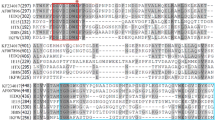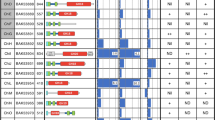Abstract
Key message
Euglena gracilis is a unicellular microalga showing characteristics of both plants and animals, and extensively used as a model organism in the research works of biochemistry and molecular biology. Biotechnological applications of E. gracilis have been conducted for production of numerous important compounds. However, chitin-mediated defense system intensively studied in higher plants remains to be investigated in this microalga. Recently, Taira et al. (Biosci Biotechnol Biochem 82:1090–1100, 2018) isolated a unique chitinase gene, comprising two catalytic domains almost homologous to each other (Cat1 and Cat2) and two chitin-binding domains (CBD1 and CBD2), from E. gracilis. We herein examined the mode of action and the specificity of the recombinant Cat2 by size exclusion chromatography and NMR spectroscopy. Both Cat1 and Cat2 appeared to act toward chitin substrate with non-processive/endo-splitting mode, recognizing two contiguous N-acetylglucosamine units at subsites − 2 and − 1. This is the first report on a chitinase having two endo-splitting catalytic domains. A cooperative action of two different endo-splitting domains may be advantageous for defensive action of the E. gracilis chitinase.
Abstract
The unicellular alga, E. gracilis, produces a chitinase consisting of two GH18 catalytic domains (Cat1 and Cat2) and two CBM18 chitin-binding domains (CBD1 and CBD2). Here, we produced a recombinant protein of the Cat2 domain to examine its mode of action as well as specificity. Cat2 hydrolyzed N-acetylglucosamine (A) oligomers (An, n = 4, 5, and 6) and partially N-acetylated chitosans with a non-processive/endo-splitting mode of action. NMR analysis of the product mixture from the enzymatic digestion of chitosan revealed that the reducing ends were exclusively A-unit, and the nearest neighbors of the reducing ends were mostly A-unit but not exclusively. Both A-unit and D-unit were found at the non-reducing ends and the nearest neighbors. These results indicated strong and absolute specificities for subsites − 2 and − 1, respectively, and no preference for A-unit at subsites + 1 and + 2. The same results were obtained from sugar sequence analysis of the individual enzymatic products from the chitosans. The subsite specificities of Cat2 are similar to those of GH18 human chitotriosidase, but differ from those of plant GH18 chitinases. Since the structures of Cat1 and Cat2 resemble to each other (99% similarity in amino acid sequences), Cat1 may hydrolyze the substrate with the same mode of action. Thus, the E. gracilis chitinase appears to act toward chitin polysaccharide chain through a cooperative action of the two endo-splitting catalytic domains, recognizing two contiguous A-units at subsites − 2 and − 1.








Similar content being viewed by others
References
Arakane Y, Taira T, Ohnuma T, Fukamizo T (2012) Chitin-related enzymes in agro-biosciences. Curr Drug Targets 13:442–470
Broglie K, Chet I, Holliday M, Cressman R, Biddle P, Knowlton S, Mauvais CJ, Broglie R (1991) Transgenic plants with enhanced resistance to the fungal pathogen Rizoctonia solani. Science 254:1194–1197
Brunner F, Stintzi A, Fritig B, Legrand M (1998) Substrate specificities of tobacco chitinases. Plant J 14:225–234
Bueter CL, Specht CA, Levitz SM (2013) Innate sensing of chitin and chitosan. PLoS Pathog 9:e1003080
Eide KB, Norberg AL, Heggset EB, Lindbom AR, Vårum KM, Eijsink VG, Sørlie M (2012) Human chitotriosidase-catalyzed hydrolysis of chitosan. Biochemistry 51:487–495
Fukamizo T, Kramer KJ, Mueller DD, Schaefer J, Garbow J, Jacob GS (1986) Analysis of chitin structure by nuclear magnetic resonance spectroscopy and chitinolytic enzyme digestion. Arch Biochem Biophys 250:312–321
Fukamizo T, Ohtakara A, Mitsutomi M, Goto S (1991) NMR spectra of partially deacetylated chitotrisaccharides. Agric Biol Chem 55:2653–2655
Heggset EB, Hoell IA, Kristoffersen M, Eijsink VG, Vårum KM (2009) Degradation of chitosans with chitinase G from Streptomyces coelicolor A3(2): production of chito-oligosaccharides and insight into subsite specificities. Biomacromolecules 10:892–899
Heggset EB, Dybvik AI, Hoell IA, Norberg AL, Sørlie M, Eijsink VG, Vårum KM (2010) Degradation of chitosans with a family 46 chitosanase from Streptomyces coelicolor A3(2). Biomacromolecules 11:2487–2497
Heggset EB, Tuveng TR, Hoell IA, Liu Z, Eijsink VG, Vårum KM (2012) Mode of action of a family 75 chitosanase from Streptomyces avermitilis. Biomacromolecules 13:1733–1741
Horn SJ, Sørbotten A, Synstad B, Sikorski P, Sorlie M, Vårum KM, Eijsink VG (2006) Endo/exo mechanism and processivity of family 18 chitinases produced by Serratia marcescens. FEBS J 273:491–503
Imoto T, Yagishita K (1971) A simple activity measurement of lysozyme. Agric Biol Chem 35:1154–1156
Inui H, Ishikawa T, Tamoi M (2017) Wax ester fermentation and its application for biofuel production. In Schwartzbach S, Shigeoka S (eds) Euglena: biochemistry, cell and molecular biology. Springer, New York, pp 269–283
Ishiguro K, Yoshie N, Sakurai M, Inoue Y (1992) A 1H NMR study of a fragment of partially n-acetylated chitin produced by lysozyme degradation. Carbohydr Res 237:333–338
Itoh T, Hibi T, Suzuki F, Sugimoto I, Fujiwara A, Inaka K, Tanaka H, Ohta K, Fujii Y, Taketo A, Kimoto H (2016) Crystal structure of chitinase ChiW from Paenibacillus sp. str. FPU-7 reveals a novel type of bacterial cell-surface-expressed multi-modular enzyme machinery. PLoS ONE 11:e0167310
Kasprzewska A (2003) Plant chitinases―regulation and function. Cell Mol Biol Lett 8:809–824
Krajčovič J, Vesteg M, Schwartzbach SD (2015) Euglenoid flagellates: a multifaceted biotechnology platform. J Biotechnol 202:135–145
Laemmli UK (1970) Cleavage of structural proteins during the assembly of the head of bacteriophage T4. Nature 227:680–685
Mitsutomi M, Kidoh H, Tomita H, Watanabe T (1995) The action of Bacillus circulans WL-12 chitinases on partially N-acetylated chitosan. Biosci Biotechnol Biochem 59:529–531
Pace CN, Vajdos F, Fee L, Grimsley G, Gray T (1995) How to measure and predict the molar absorption coefficient of a protein. Protein Sci 4:2411–2423
Rupley JA (1964) The hydrolysis of chitin by concentrated hydrochrolic acid, and the preparation of low-molecular-weight substrates for lysozyme. Biochim Biophys Acta 83:245–255
Sannan T, Kurita K, Iwakura Y (1976) Study on chitin 2, effect of deacetylation on solubility. Makromol Chem 177:3589–3600
Sasaki C, Yokoyama A, Itoh Y, Hashimoto M, Watanabe T, Fukamizo T (2002) Comparative study of the reaction mechanism of family 18 chitinases from plants and microbes. J Biochem 131:557–564
Sasaki C, Itoh Y, Takehara H, Kuhara S, Fukamizo T (2003) Family 19 chitinase from rice (Oryza sativa L.): substrate-binding subsites demonstrated by kinetic and molecular modeling studies. Plant Mol Biol 52:43–52
Sasaki C, Vårum KM, Itoh Y, Tamoi M, Fukamizo T (2006) Rice chitinases: sugar recognition specificities of the individual subsites. Glycobiology 16:1242–1250
Schlumbaum A, Mauch F, Vögeli U, Boller T (1986) Plant chitinases are potent inhibitors of fungal growth. Nature 324:365–367
Sørbotten A, Horn SJ, Eijsink VGH, Vårum KM (2005) Degradation of chitosans with chitinase B from Serratia marcescens. Production of chito-oligosaccharides and insight into enzyme processivity. FEBS J 272:538–549
Taira T, Gushiken C, Sugata K, Ohnuma T, Fukamizo T (2018) Unique GH18 chitinase from Euglena gracilis: full-length cDNA cloning and characterization of its catalytic domain. Biosci Biotechnol Biochem 82:1090–1100
Tanaka T, Fujiwara S, Nishikori S, Fukui T, Takagi M, Imanaka T (1999) A unique chitinase with dual active sites and triple substrate binding sites from the hyperthermophilic archaeon Pyrococcus kodakaraensis KOD1. Appl Environ Microbiol 65:5338–5344
Tanaka T, Fukui T, Imanaka T (2001) Different cleavage specificities of the dual catalytic domains in chitinase from the hyperthermophilic archaeon Thermococcus kodakaraensis KOD1. J Biol Chem 276:35629–35635
Tews I, van Scheltinga ACT, Perrakis A, Wilson KS, Dijkstra BW (1997) Substrate-assisted catalysis unifies two families of chitinolytic enzymes. J Am Chem Soc 119:7954–7959
van Aalten DM, Komander D, Synstad B, Gåseidnes S, Peter MG, Eijsink VG (2001) Structural insights into the catalytic mechanism of a family 18 exo-chitinase. Proc Natl Acad Sci USA 98:8979–8984
Vårum KM, Anthonsen M, Grasdalen H, Smidsrød O (1991) Determination of the degree of N-acetylation and the distribution of N-acetyl group in partially N-acetylated chitins (chitosans) by high-field n.m.r. spectroscopy. Carbohydr Res 211:17–23
Vårum KM, Holme HK, Izume M, Stokke BT, Smidsrod O (1996) Determination of enzymatic hydrolysis specificity of partially N-acetylated chitosans. Biochim Biophys Acta 1291:5–15
Acknowledgements
In memory of Professor Kjell Morten Vårum, NTNU, who passed away during this work. We are grateful to his sincere and zealous leadership in this collaborative project.
Funding
YK was supported by Scandinavia-Japan Sasakawa Foundation and KIFEE 2016–2018 program (Grant 249797) from the Research Council of Norway (RCN). YF was supported by the MARPOL project, and NNP—Norwegian NMR Platform (Grants 221576 and 226244 from the RCN, respectively) as well as the program of China Scholarship Council.
Author information
Authors and Affiliations
Contributions
TT, TO, and TF planned this work, YF, JT and YK performed experiments, YF, YK, FLA, TO and TF analyzed the data, and YF, YK, FLA, and TF wrote the paper.
Corresponding author
Rights and permissions
About this article
Cite this article
Feng, Y., Kitaoku, Y., Tanaka, J. et al. Mode of action and specificity of a chitinase from unicellular microalgae, Euglena gracilis. Plant Mol Biol 97, 553–564 (2018). https://doi.org/10.1007/s11103-018-0759-0
Received:
Accepted:
Published:
Issue Date:
DOI: https://doi.org/10.1007/s11103-018-0759-0




